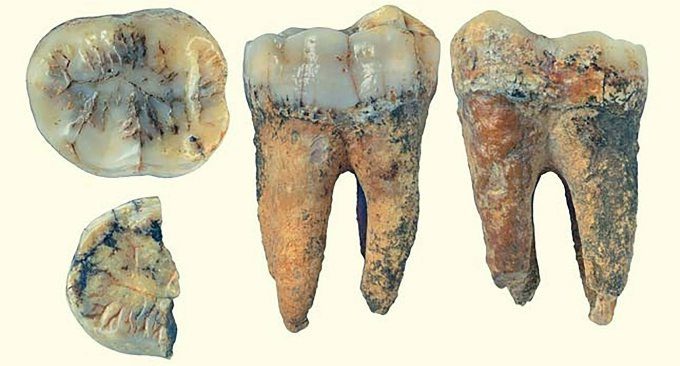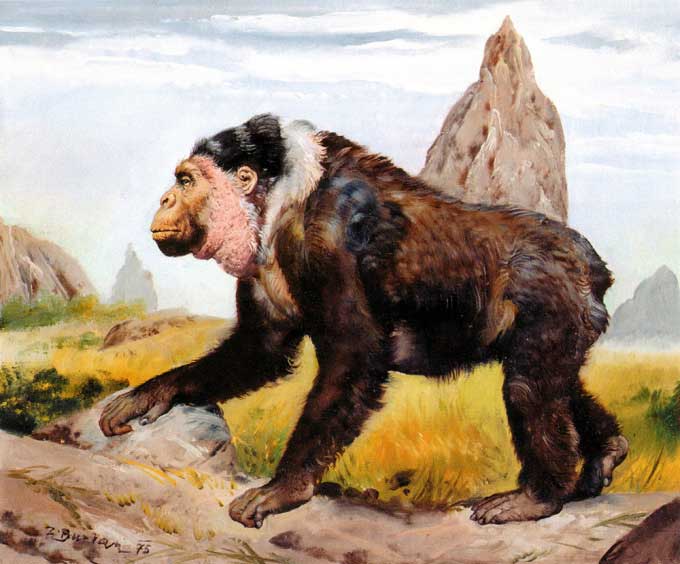Scientists Discover Two Tooth Samples of a Giant Ape, the Only Find from the Pleistocene Epoch in Vietnam.
The research was conducted by experts from the Institute of Paleobiology, Russian Academy of Sciences, and the Vietnam-Russia Tropical Center, including Dr. Le Xuan Dak, Dr. Mashchenko E.N., and their colleagues.
From 2020 to 2022, scientists surveyed Lang Trang Cave, Cang Nang Town, Ba Thuoc District, Thanh Hoa Province. The research team analyzed ancient paleontological samples collected and discovered two tooth samples of the giant ape (Gigantopithecus blacki). This is the only find from the Pleistocene epoch in Vietnam and one of the most recent tooth samples recorded among extinct species (approximately 125,000 years ago).

Lower jaw of the giant ape at Lang Trang Cave. (Photo: Russian Academy of Sciences).
According to the information portal of the Vietnam-Russia Tropical Center, scientists analyzed the morphological characteristics and sizes of the tooth bodies found in Lang Trang Cave, which correspond to those of the giant ape – G. blacki and revealed similarities in enamel thickness, size, and shape of the tooth roots. The enamel surface showed scratches and tiny pitting marks, which are characteristic features of primate teeth.
G. blacki is closely related to the Orangutan, the largest species in the primate group, weighing between 200-300 kg. The giant ape roamed the forests of Southeast Asia before going extinct hundreds of thousands of years ago. However, fossils of the giant ape are extremely rare and difficult to find. Previously, paleontological remains of the giant ape were fragments of teeth and jawbones collected from Pleistocene sediments in limestone caves in southern China. Isolated teeth have also been discovered in northern Vietnam and northern Thailand. Some fragments of jawbone from a giant ape of indeterminate geological age were found on Java (Indonesia), corresponding in size to G. blacki, classified as Gigantopithecus sp.
Analyzing the geographical distribution and stratigraphy of Gigantopithecus, scientists believe that the paleontological samples discovered in Lang Trang Cave belong to one of the most recent records of the giant ape still remaining today.

Graphic simulation of the giant ape’s appearance. (Image: Artist Z. Burian)
In their research at Lang Trang Cave, scientists also identified 41 species belonging to different taxonomic units, while proposing hypotheses about the paleoenvironments during this period. Species first identified from the Lang Trang fauna include the giant ape (Gigantopithecus blacki), long-tailed macaque (Macaca cf. fascicularis), golden monkey (M. cf. mulatta), clouded leopard (Neofelis nebulosa), shrew (Chodsigoa hoffmanni), bat (Ia io), giant long-tailed rat Neill (Leopoldamys neilli), black rat (Rattus rattus), Indian rhinoceros (Rhinoceros unicornis), Bornean babirusa (Sus barbatus), Sambar deer (Tragulus kanchil), water deer (Hydropotes inermis), hog deer (Axis porcinus), crocodiles, turtles, and several terrestrial gastropod species.
In Vietnam, prior to the 2000s, some paleontological research teams surveyed Lang Trang Cave and its surrounding areas. The limestone Lang Trang Cave is a well-known paleontological site due to the discovery of prehistoric human fossils and more than 30 other species belonging to the Stegodon – Ailuropoda fauna, characteristic of the late Middle to late Pleistocene. Research results on the Pleistocene fauna at Lang Trang Cave have indicated ecological adaptations, distribution dynamics of ancient and modern animal species, changes in fauna, and ancient environmental conditions. New paleontological data serve as scientific evidence for analyzing and forecasting biodiversity dynamics of the modern animal fauna of Vietnam.


















































